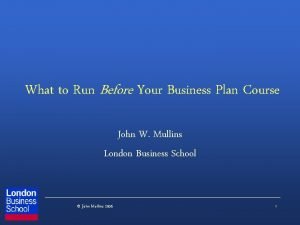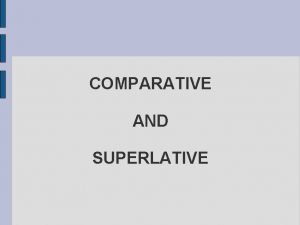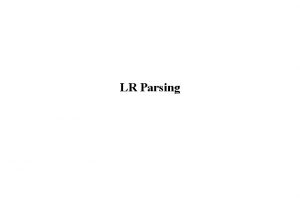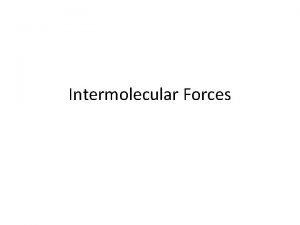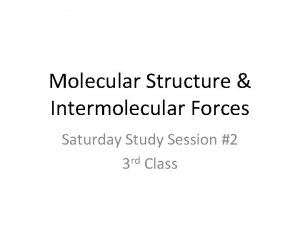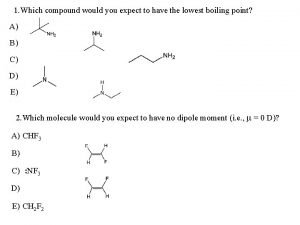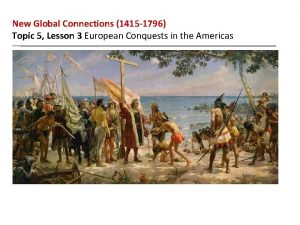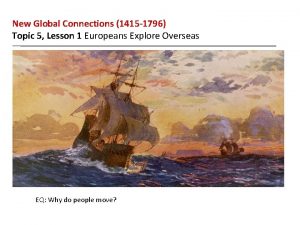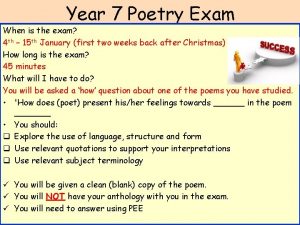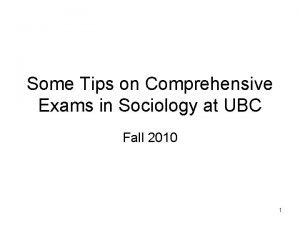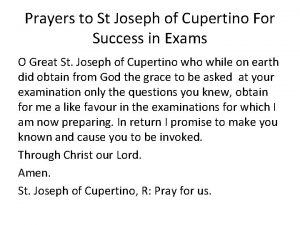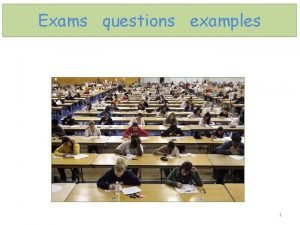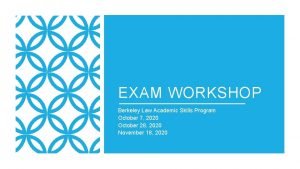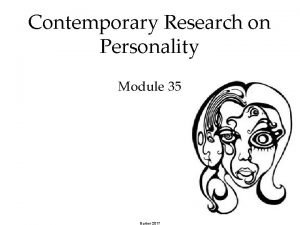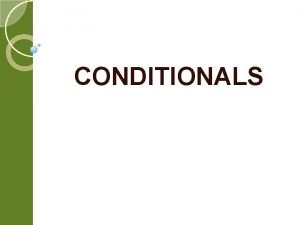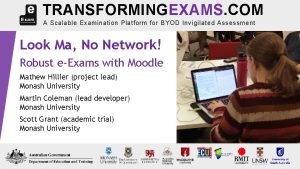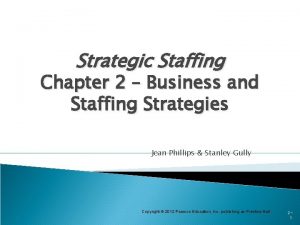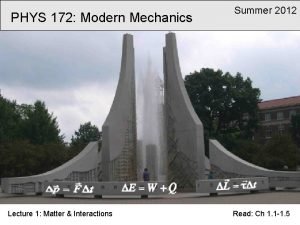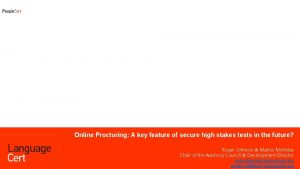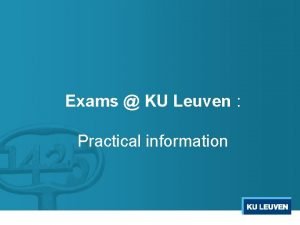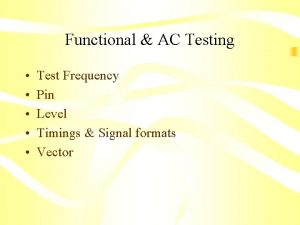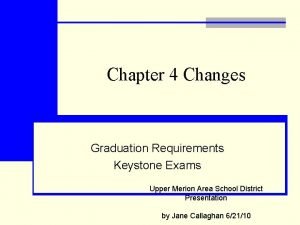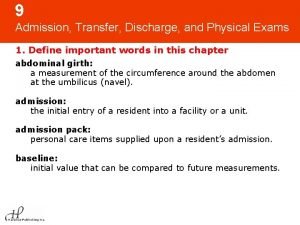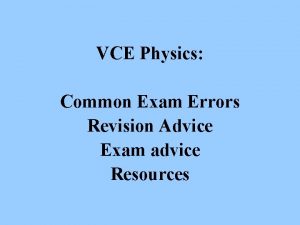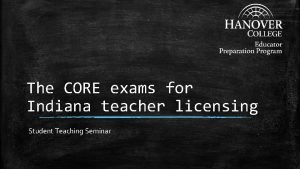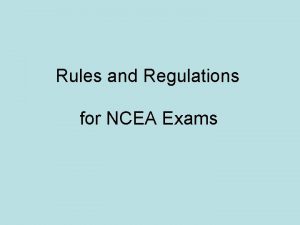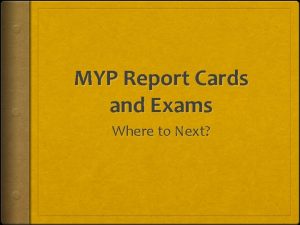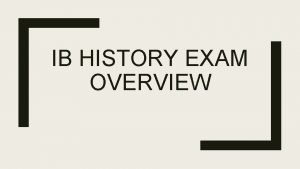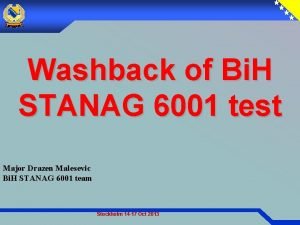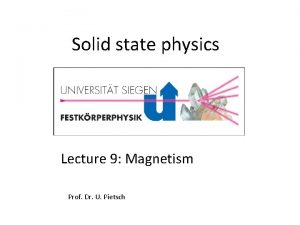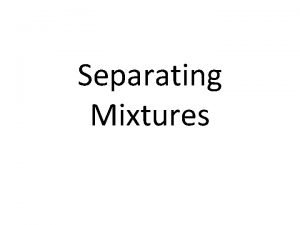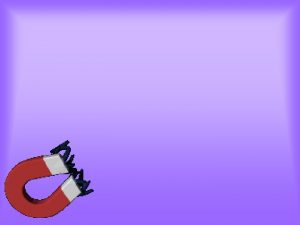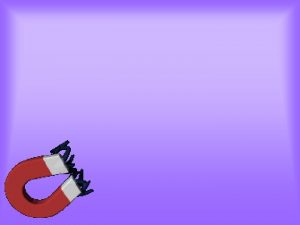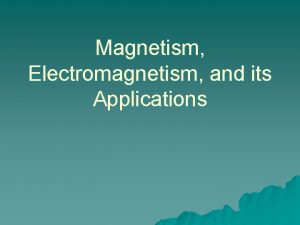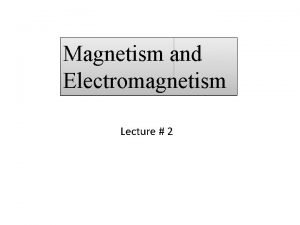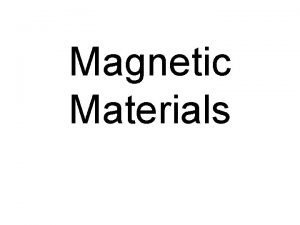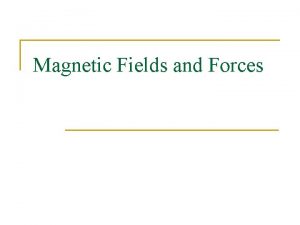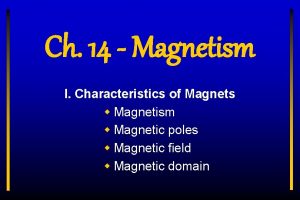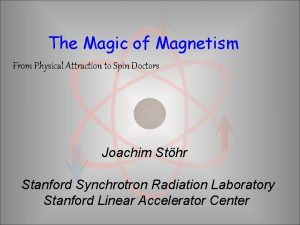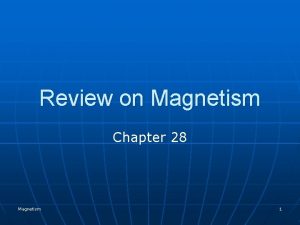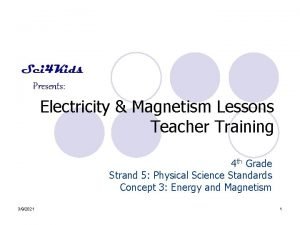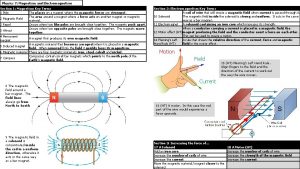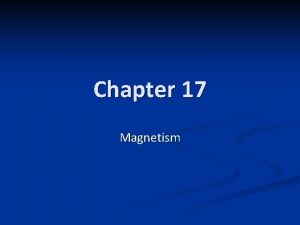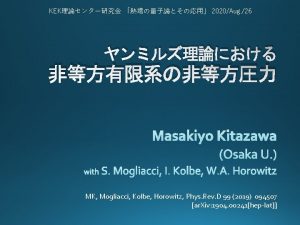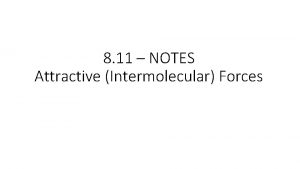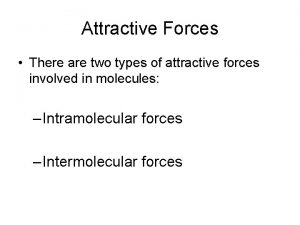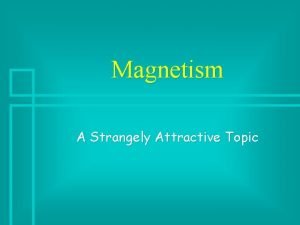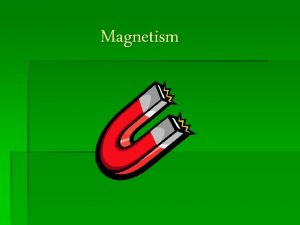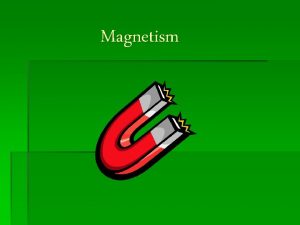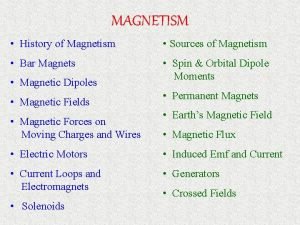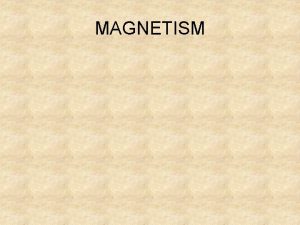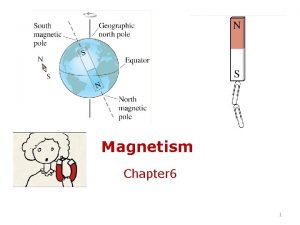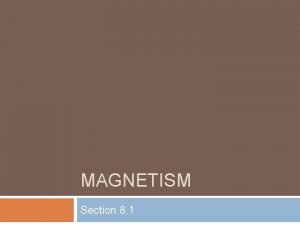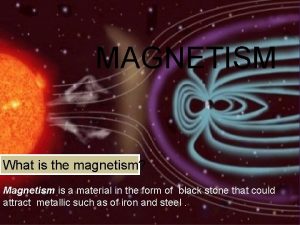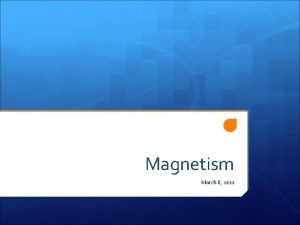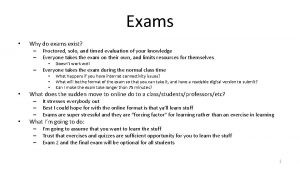Magnetism An Attractive New Topic Magnetism 1 EXAMS
















































































- Slides: 80

Magnetism An Attractive New Topic Magnetism 1

EXAMS RETURNED WELCOME BACK Magnetism 2

What’s Up? n n n Return Exam#2 papers Begin study of magnetism. Watch for Web. Assign shortly Magnetism 3

How Did You Do? ? § § § Magnetism A. 80 -100 B. 60 -79 C. 40 -59 D. 20 -39 E. 0 -19 F. Less than 0 4

High = 95% Low = 9% EXAM #2 20 18 16 14 12 10 8 6 4 2 0 1 Magnetism 2 3 4 5 50 6 -5 9 7 8 9 10 5

Did the Card Help? A. B. C. D. Magnetism A Lot A Little Not really No 6

Magnetism was known long ago. Magnetism 7

Lodestone (Mineral) • Lodestones attracted iron filings. • Lodestones seemed to attract each other. • Lodestone is a natural magnet. Magnetism 8

New Concept The Magnetic Field – We give it the symbol B. – A compass will line up with it. – It has Magnitude and direction so it is a VECTOR. • There are some similarities with the Electric Field but also some significant differences. Magnetism 9

Magnetism • Refrigerators are attracted to magnets! Magnetism 10

Where is Magnetism Used? ? • Motors • Navigation – Compass • Magnetic Tapes – Music, Data • Television – Beam deflection Coil • Magnetic Resonance Imaging • High Energy Physics Research Magnetism 11

Magnetism MAGNET DEMO – COMPARE TO ELECTROSTATICS N Magnet What Happens? ? S Pivot 12

Magnetism RESULTS - MAGNETS Like Poles Repel � Opposite Poles Attract � Magnetic Poles are only found in pairs. � S N � Shaded End is NORTH Pole Shaded End of a compass points to the NORTH. No magnetic monopoles have ever been observed. 13

Magnetism OBSERVATIONS � � � Bring a magnet to an electrically charged object and the observed attraction will be a result of charge induction or polarization. Magnetic poles do not interact with stationary electric charges. Bring a magnet near some metals (Co, Fe, Ni …) and it will be attracted to the magnet. � � � The metal will be attracted to both the N and S poles independently. Some metals are not attracted at all. (Al, Cu, Ag, Au) Wood is NOT attracted to a magnet. Neither is water. A magnet will force a compass needle to align with it. (No big Surprise. ) 14

Magnetism MAGNETS ld Fie c eti n g Ma N S Cutting a bar magnet in half produces TWO bar magnets, each with N and S poles. 15

Magnetism CONSIDER A PERMANENT MAGNET N S The magnetic Field B goes from North to South. 16

Magnetism INTRODUCE ANOTHER PERMANENT MAGNET N N S pivot S The bar magnet (a magnetic dipole) wants to align with the B-field. 17

Magnetism FIELD OF A PERMANENT MAGNET N N S S The south pole of the small bar magnet is attracted towards the north pole of the big magnet. The North pole of the small magnet is repelled by the north pole of the large magnet. The South pole of the large magnet creates a smaller force on the small magnet than does the North pole. DISTANCE effect. The field attracts and exerts a torque on the small magnet. 18

Magnetism FIELD OF A PERMANENT MAGNET N N S S The bar magnet (a magnetic dipole) aligns with the B-field. It is now happy! 19

Magnetism TALK ABOUT TORQUE – BACK TO THE PAST If the two charges are rigidly held together in this way, the Charges behave similarly to a magnet in a magnetic field. This structure is referred to as a DIPOLE. Usually, “a” is very small. 20

Magnetism IMPORTANT: THE ELECTRIC DIPOLE ALIGNS ITSELF WITH THE ELECTRIC FIELD (- To +) p p is the electric dipole moment 21

Magnetism ELECTRIC FIELD OF AN ELECTRIC DIPOLE Electric Field Magnetic Field The magnet behaves just like the Electric dipole and aligns itself with A MAGNETIC field. Similarities will continue. 22

Magnetism CONVENTION FOR MAGNETIC FIELDS X Field INTO Paper B Field OUT of Paper 23

TYPICAL REPRESENTATION Magnetism B B is a vector! 24

Magnetism When placed in an electric or magnetic field, equal but opposite forces arise on each side of the dipole creating a torque τ: for an electric dipole moment p (in coulomb-meters), or for a magnetic dipole moment m (in ampere-square meters). The resulting torque will tend to align the dipole with the applied field, which in the case of an electric dipole, yields a potential energy of . The energy of a magnetic dipole is similarly . 25

Magnetism EXPERIMENTS WITH MAGNETS SHOW � Current carrying wire produces a circular magnetic field around it. � Force (actually torque) on a Compass Needle (or magnet) increases with current. 26

Magnetism CURRENT CARRYING WIRE Current into the page. B Right hand Rule. Thumb in direction of the current Fingers curl in the direction of B 27

Magnetism CURRENT CARRYING WIRE � B field is created at ALL POINTS in space surrounding the wire. � The B field has magnitude and direction. � Force on a magnet increases with the current. � Force is found to vary as ~(1/d) from the wire. 28

Magnetism COMPASS AND B FIELD � Observations North Pole of magnets tend to move toward the direction of B while S pole goes the other way. � Field exerts a TORQUE on a compass needle. � Compass needle is a magnetic dipole. � North Pole of compass points toward the NORTH. � The NORTH geographic pole of the planet is therefore a � 29

Magnetism PLANET EARTH 30

Magnetism INSIDE IT ALL. 8000 Miles 31

Magnetism ON THE SURFACE IT LOOKS LIKE THIS. . 32

Magnetism INSIDE: WARMER THAN FLORIDUH 33

Magnetism MUCH WARMER THAN FLORIDUH 34

Magnetism FINALLY 35

Magnetism IN BETWEEN The molten iron core exists in a magnetic field that had been created from other sources (sun…). � The fluid is rotating in this field. � This motion causes a current in the molten metal. � The current causes a magnetic field. � The process is self-sustaining. � The driving force is the heat (energy) that is generated in the core of the planet. � 36

Magnetism After molten lava emerges from a volcano, it solidifies to a rock. In most cases it is a black rock known as basalt, which is faintly magnetic, like iron emerging from a melt. Its magnetization is in the direction of the local magnetic force at the time when it cools down. Instruments can measure the magnetization of basalt. Therefore, if a volcano has produced many lava flows over a past period, scientists can analyze the magnetizations of the various flows and from them get an idea on how the direction of the local Earth's field varied in the past. Surprisingly, this procedure suggested that times existed when the magnetization had the opposite direction from today's. All sorts of explanation were proposed, but in the end the only one which passed all tests was that in the distant past, indeed, the magnetic polarity of the Earth was sometimes reversed. 37

Magnetism REPEAT Navigation DIRECTION N S If N direction is pointed to by the NORTH pole of the Compass Needle, then the pole at the NORTH of our planet must be a SOUTH MAGNETIC POLE! Compass Direction Navigation DIRECTION S N And it REVERSES from time to time. 38

Magnetism ROWLAND’S EXPERIMENT Field is created by any moving charge. Rotating INSULATING Disk which is CHARGED + or – on exterior. ++ + + ++ xxx B xxx Increases with charge on the disk. Increases with angular velocity of the disk. Electrical curent is a moving charge. 39

Magnetism A LOOK AT THE PHYSICS q There is NO force on a charge placed into a magnetic field if the charge is NOT moving. There is no force if the charge moves parallel to the field. q • If the charge is moving, there is a force on the charge, perpendicular to both v and B. F = q v x B 40

Magnetism WHAT THE HECK IS THAT? ? ? � A WHAT PRODUCT? � A CROSS PRODUCT – Like an angry one? ? � Alas, yes …. � F=qv X B 41

Magnetism THE LORENTZ FORCE This can be summarized as: F or: v B mq q is the angle between B and V 42

Magnetism NICER PICTURE 43

Magnetism ANOTHER PICTURE 44

Magnetism VECTOR CALCULATIONS 45

Magnetism PRACTICE B and v are parallel. Crossproduct is zero. So is the force. Which way is the Force? ? ? 46

Magnetism UNITS 47

TE S Magnetism LAS ARE 48

Magnetism THE MAGNETIC FORCE IS DIFFERENT FROM THE ELECTRIC FORCE. Whereas the electric force acts in the same direction as the field: The magnetic force acts in a direction orthogonal to the field: (Use “Right-Hand” Rule to determine direction of F) And --- the charge must be moving !! 49

WIRES A wire with a current contains moving charges. A magnetic field will apply a force to those moving charges. This results in a force on the wire itself. The electron’s sort of PUSH on the side of the wire. F Remember: Electrons go the “other way”. Magnetism 50

Magnetism THE WIRE IN MORE DETAIL Assume all electrons are moving with the same velocity vd. L B out of plane of the paper 51

Magnetism MAGNETIC LEVITATION Magnetic Force mg Where does B point? ? Current = i Into the paper. 52

Magnetism MAGLEV 53

Magnetism A conductor suspended by two flexible wires as shown in the diagram has a mass per unit length of 0. 040 0 kg/m. What current must exist in the conductor in order for the tension in the supporting wires to be zero when the magnetic field is 3. 60 T into the page? What is the required direction for the current? Concrete Insulator 54

Magnetism THERE WAS A CROOKED MAN WHO LIVED IN A CROOKED HOUSE THAT WAS WIRED WITH CROOKED WIRES 55

Magnetism CROOKED WIRE (IN A PLANE) IN A CONSTANT B FIELD 56

Magnetism CASE 1 The magnetic force on a curved current carrying conductor in a uniform magnetic field is the same as that of a straight conductor carrying the same current between the two points a and b. 57

Magnetism CASE 2 The net magnetic force on a closed current carrying loop is ZERO! 58

Magnetism CURRENT LOOP What is force on the ends? ? Loop will tend to rotate due to the torque the field applies to the loop. 59

Magnetism THE LOOP (FROM THE TOP) OBSERVATION Force on Side 2 is out of the paper and that on the opposite side is into the paper. No net force tending to rotate the loop due to either of these forces. The net force on the loop is also zero, pivot 60

Magnetism AN APPLICATION THE GALVANOMETER 61

Magnetism THE OTHER SIDES t 1=F 1 (b/2)Sin(q) =(B i a) x (b/2)Sin(q) total torque on the loop is: 2 t 1 Total torque: t=(ia. B) b. Sin(q) =i. ABSin(q) (A=Area) 62

Magnetism A COIL Normal to the coil RIGHT HAND RULE TO FIND NORMAL TO THE COIL: “Point or curl you’re the fingers of your right hand in the direction of the current and your thumb will point in the direction of the normal to the coil. 63

Magnetism DIPOLE MOMENT DEFINITION Define the magnetic dipole moment of the coil m as: m=Ni. A t=m X B We can convert this to a vector with A as defined as being normal to the area as in the previous slide. 64

Magnetism A 40. 0 -cm length of wire carries a current of 20. 0 A. It is bent into a loop and placed with its normal perpendicular to a magnetic field with a magnitude of 0. 520 T. What is the torque on the loop if it is bent into (a)an equilateral triangle? (b)What is the torque if the loop is (c) a square or (d) a circle? (e) Which torque is greatest? 65

Magnetism MOTION OF A CHARGED PARTICLE IN A MAGNETIC FIELD 66

Magnetism TRAJECTORY OF CHARGED PARTICLES IN A MAGNETIC FIELD + B + (B field points into plane of paper. ) + + v + + F + + + +B + v+ + + + F + + + + + 67

TRAJECTORY OF CHARGED PARTICLES IN A MAGNETIC FIELD Magnetism (B field points into plane of paper. ) v+ + B + +B + v + + + F + + + + + + Magnetic Force is a centripetal force 68

REVIEW OF ROTATIONAL Magnetism MOTION = s / r s = r ds/dt = d /dt r v = r s r = angle, = angular speed, = angular acceleration at ar at = r tangential acceleration ar = v 2 / r radial acceleration The radial acceleration changes the direction of motion, while the tangential acceleration changes the speed. Uniform Circular Motion ar = constant v and ar constant but direction changes v ar = v 2/r = 2 r KE = ½ mv 2 = ½ mw 2 r 2 F = mar = mv 2/r = m 2 r 69

Magnetism 70

Magnetism RADIUS OF A CHARGED PARTICLE ORBIT IN A MAGNETIC FIELD +B + v+ + + r + + + F Centripetal Magnetic = Force Force Note: as , the magnetic force does no work! 71

Magnetism CYCLOTRON FREQUENCY +B + v + + + r + + + F + The time taken to complete one orbit is: 72

Magnetism MORE CIRCULAR TYPE MOTION IN A MAGNETIC FIELD 73

Magnetism Review Problem. An electron moves in a circular path perpendicular to a constant magnetic field of magnitude 1. 00 m. T. The angular momentum of the electron about the center of the circle is 4. 00 × 10– 25 J · s. Determine: (a)the radius of the circular path and (b)the speed of the electron. 74

Magnetism MASS SPECTROMETER Smaller Mass 75

Magnetism 76

Magnetism AN EXAMPLE A beam of electrons whose kinetic energy is K emerges from a thin-foil “window” at the end of an accelerator tube. There is a metal plate a distance d from this window and perpendicular to the direction of the emerging beam. Show that we can prevent the beam from hitting the plate if we apply a uniform magnetic field B such that 77

Magnetism PROBLEM CONTINUED r 78

Magnetism Let’s Look at the effect of crossed E and B Fields: x x x E x x x B v q , m • 79

Magnetism What is the relation between the intensities of the electric and magnetic fields for the particle to move in a straight line ? . x x x E x x x v q • m B FE = q E and FB = q v B If FE = FB the particle will move following a straight line trajectory q. E=qv. B v=E/B FB FE • 80
 New york state teacher certification exams
New york state teacher certification exams Unity and coherence
Unity and coherence Topic about internet
Topic about internet Intermolecular and intramolecular forces
Intermolecular and intramolecular forces Segment attractiveness matrix
Segment attractiveness matrix Seven domains of attractive opportunities
Seven domains of attractive opportunities Seven domains of attractive opportunities
Seven domains of attractive opportunities Attractive meaning
Attractive meaning Attractive sce
Attractive sce Attractive force
Attractive force Superlativo de special
Superlativo de special The seven domains of attractive opportunities
The seven domains of attractive opportunities Which of these is also known as look-head lr parser?
Which of these is also known as look-head lr parser? Ion induced dipole examples
Ion induced dipole examples No- structure
No- structure Attractive forces
Attractive forces New global connections
New global connections Topic 5 review questions new global connections answer key
Topic 5 review questions new global connections answer key Poem structure and form
Poem structure and form Maarit haikonen
Maarit haikonen Adit qualification
Adit qualification Comprehensive exams
Comprehensive exams Prayer to st joseph cupertino for exams
Prayer to st joseph cupertino for exams Prayer before exam results
Prayer before exam results Physical assessment types
Physical assessment types Example of exams
Example of exams Berkeley law exams
Berkeley law exams English official exams
English official exams Judy believes that her fate is determined
Judy believes that her fate is determined Conditionals finish the sentences
Conditionals finish the sentences Byod exams
Byod exams Strategic staffing definition
Strategic staffing definition Phys 172
Phys 172 Biometric assisted proctoring
Biometric assisted proctoring Invigilator cambridge exams
Invigilator cambridge exams Hrm question paper
Hrm question paper Ku leuven exam results
Ku leuven exam results Chapter 9 admission transfer discharge and physical exams
Chapter 9 admission transfer discharge and physical exams York uni vle
York uni vle Exams actesting
Exams actesting Are the keystone exams mandatory
Are the keystone exams mandatory Admission transfer discharge and physical exams
Admission transfer discharge and physical exams Vce physics resources
Vce physics resources Rcpch exams
Rcpch exams University of auckland aegrotat
University of auckland aegrotat Indiana teacher certification practice test
Indiana teacher certification practice test Derived grade exams
Derived grade exams Placement exams yale
Placement exams yale Decas exams
Decas exams Paragraph about exams
Paragraph about exams Myp exams
Myp exams Ib history of the americas study guide
Ib history of the americas study guide Witr salah
Witr salah Stanag 6001 test
Stanag 6001 test Www.awinfosys.com/eassessment/exams sample.htm
Www.awinfosys.com/eassessment/exams sample.htm Aspec exams
Aspec exams 4 forces of nature
4 forces of nature Ib physics topic 5
Ib physics topic 5 Magnetism love
Magnetism love Magnetism
Magnetism Example of use of magnet mixture
Example of use of magnet mixture Electricity and magnetism lecture notes
Electricity and magnetism lecture notes Aportaciones de hans christian oersted
Aportaciones de hans christian oersted It is an invisible force
It is an invisible force Magnetism is an invisible
Magnetism is an invisible Magnetism and electromagnetism
Magnetism and electromagnetism Relative permeability of magnetic material
Relative permeability of magnetic material Electromagnetic particle inspection
Electromagnetic particle inspection Magnetic flux units
Magnetic flux units Facts about magnetism
Facts about magnetism Time varying fields and maxwell's equations
Time varying fields and maxwell's equations Lisa exposes an iron paper clip to a very strong magnet
Lisa exposes an iron paper clip to a very strong magnet Magnetism jeopardy
Magnetism jeopardy Conceptual physics magnetism
Conceptual physics magnetism Characteristics of magnetism
Characteristics of magnetism Joachim stöhr
Joachim stöhr Sph3u electricity and magnetism
Sph3u electricity and magnetism Magnetism
Magnetism Basics of magnetism
Basics of magnetism Magnetism and electromagnetism
Magnetism and electromagnetism Relationship between electricity and magnetism
Relationship between electricity and magnetism






